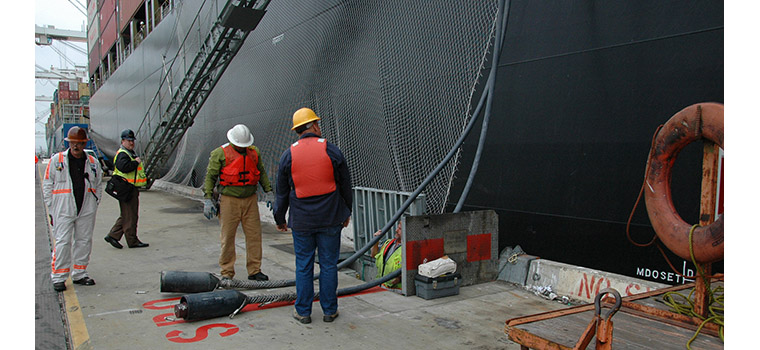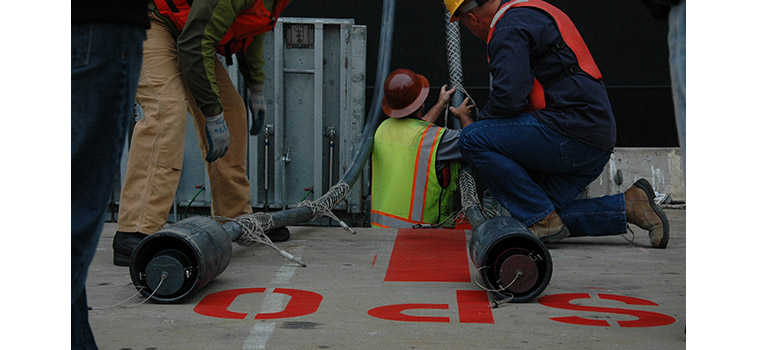The Port of Oakland has announced it will assemble a task force to review its existing Maritime Air Quality Improvement Plan (MAQIP) and recommend changes in anticipation of projected growth at the port.

Since 2012, vessels docked at the Port of Oakland have been able to switch off their diesel-powered engines and plug into an on-land electrical grid to keep onboard lighting and equipment operational while berthed. Photo courtesy of Port of Oakland
BY BILL PICTURE
Published: January, 2018
The Port of Oakland has announced it will assemble a task force to review its existing Maritime Air Quality Improvement Plan (MAQIP) and recommend changes in anticipation of projected growth at the port. The MAQIP was created in 2009 to serve as a 10-year roadmap for reducing emissions from cargo operations at the port, and it has been backbone of the port’s environmental policy ever since.
Port spokesperson Mike Zampa said the port is expecting record-breaking cargo volume this year, and the forecast looks much the same through 2022. “More cargo means more intensive operations,” Zampa said. “We have to look at the impact of those operations on the community—more traffic, more diesel emissions. We have to ask ourselves, ‘How do we mitigate that?’”
The group tasked with overhauling the 2009 plan will include transportation officials, civic leaders, environmental experts and members of the local community. The task force will begin brainstorming in the coming months, and will be expected to submit a new plan for curbing emissions to port commissioners for a vote in the third quarter of 2018.
Leaning heavily on tech
Zampa expects that new plan to reflect ever-evolving green technology, including zero- and near-zero emission cargo handling equipment and trucks. “The biggest trucking company at the port is already getting ready to test the first battery-operated semi,” he said. “Who knows what other technologies are out there?”
Zampa points to the port’s shore power program as evidence of the growing role that technology will play in curbing emissions moving forward. Since 2012, vessels docked at the Port of Oakland have been able to switch off their diesel-powered engines and plug into an on-land electrical grid to keep onboard lighting and equipment operational while berthed. More than 70 percent of docked vessels now tap into the port’s shore power, and the program has helped the port achieve a 76 percent reduction in diesel emissions over the last decade.
The reason every ship can’t take advantage of shore power is that ships come in different shapes and sizes, and some don’t align with the port’s utility vault. What those ships need in order to tie into the port’s power grid are portable cables—like giant extension cords on reels that can be easily stored when not in use and brought out when needed.
Zampa said such cables already exist, but like so many other promising technologies, they are still being perfected. “There’s also a hood being developed that can be put over the smokestack of a vessel to capture the ship’s emissions,” he said.
“That hood connects to a barge where the emissions can be scrubbed. It’s the craziest thing. We’re actually talking with the companies that are developing this idea.” He laughed. “They call it a ‘bonnet.’”
Staying ahead of Sacramento
The State of California is in the process of drafting its own updated guidelines for the cargo transport industry. While no one’s sure exactly what is coming down the pipeline from Sacramento, Zampa believes it’s safe to assume zero- and near-zero-emission technologies will figure heavily into the state’s plan.
“I think we all want the same thing—for operations at the ports to be as clean as possible,” he said. “And it’s a good bet that by the time the beginning of the next decade rolls around, their guidelines will begin being enforced.”
If the original MAQIP is any indication of the lengths to which the port will go to reduce emissions, Oakland should have no problem aligning with new state guidelines. In fact, it’s quite possible the emissions limits established in the updated MAQIP may be even stricter than the state’s.
“I think we’ve shown that we’re committed,” Zampa said. “We want to look at anything and everything that’s practical and can help us mitigate the impact of global trade.” Practical is a key word, he added, as any effort undertaken by the port must be affordable and cannot interfere with operations.
“We can’t afford to slow down the flow of cargo,” he said. “We want the port to keep growing, but we want it to grow in a fashion that’s compatible with the health of the environment and our community. So we’re ready to start looking at what new ideas and technologies are out there, and start the testing and implementing phase. We’re ready for round two of all of that; we’re ready for the next chapter.”

Some ships need portable cables in order to tie into the portís power grid, and the port hopes to make that new technology a part of the impending update to its clean-air plan. The shore power program has led to a 76 percent decline in ship emissions at the port. Photo courtesy of Port of Oakland

